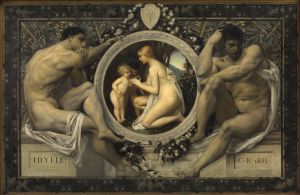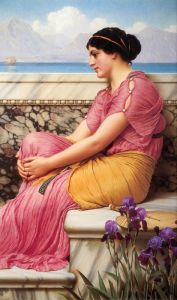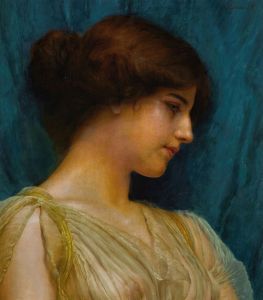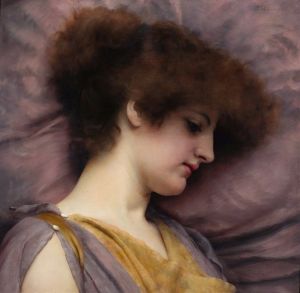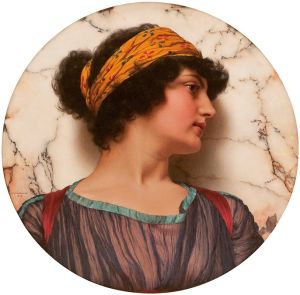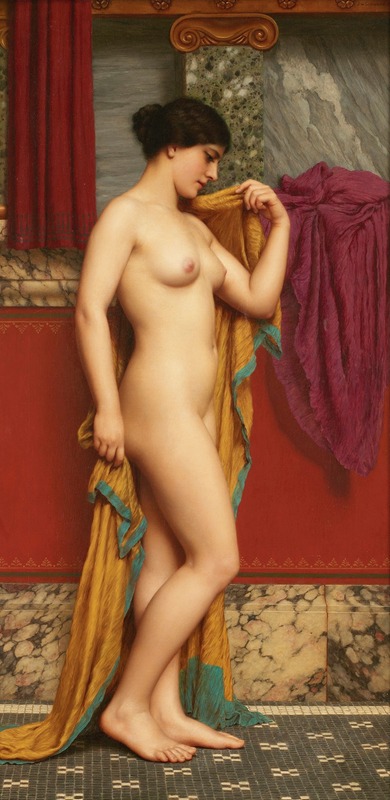
In The Tepidarium
A hand-painted replica of John William Godward’s masterpiece In The Tepidarium, meticulously crafted by professional artists to capture the true essence of the original. Each piece is created with museum-quality canvas and rare mineral pigments, carefully painted by experienced artists with delicate brushstrokes and rich, layered colors to perfectly recreate the texture of the original artwork. Unlike machine-printed reproductions, this hand-painted version brings the painting to life, infused with the artist’s emotions and skill in every stroke. Whether for personal collection or home decoration, it instantly elevates the artistic atmosphere of any space.
"In The Tepidarium" is a painting by the English artist John William Godward, created in 1913. Godward was a prominent figure in the late 19th and early 20th centuries, known for his classical style and meticulous attention to detail. He was part of the Neoclassical movement, which sought to revive the art and culture of ancient Greece and Rome.
The title "In The Tepidarium" refers to a specific room in Roman baths. The tepidarium was a warm room used to acclimate bathers to the heat of the caldarium, the hot bath. This setting is indicative of Godward's fascination with classical antiquity and his desire to recreate the elegance and serenity of that era.
The painting depicts a young woman reclining on a marble bench within the tepidarium. She is dressed in a flowing, semi-transparent garment that drapes gracefully over her body, highlighting Godward's skill in rendering the textures and folds of fabric. The woman's pose is relaxed, and she gazes thoughtfully into the distance, contributing to the overall sense of calm and introspection that characterizes the scene.
Godward's use of color and light in "In The Tepidarium" is particularly noteworthy. The warm tones of the woman's skin contrast with the cool, smooth surfaces of the marble bench and the tiled floor, creating a harmonious balance. The background features intricate mosaic patterns, which add to the authenticity and historical accuracy of the setting. This attention to detail is a hallmark of Godward's work and reflects his dedication to capturing the beauty and refinement of classical antiquity.
The painting is also a testament to Godward's technical prowess. His ability to render the human form with such precision and grace is evident in the delicate features of the woman's face and the naturalistic depiction of her body. The play of light and shadow on her skin and clothing further enhances the three-dimensional quality of the figure, making her appear almost lifelike.
"In The Tepidarium" is one of Godward's many works that celebrate the idealized beauty of the classical world. His paintings often feature solitary female figures in tranquil, timeless settings, evoking a sense of nostalgia for a bygone era. This focus on beauty and serenity was a defining characteristic of Godward's art and set him apart from many of his contemporaries, who were increasingly drawn to modernist and avant-garde movements.
Despite his success, Godward's adherence to classical themes and techniques eventually fell out of favor as the art world moved towards more experimental and abstract styles. Nevertheless, his work has experienced a resurgence of interest in recent years, with art historians and collectors recognizing the enduring appeal of his meticulous craftsmanship and classical sensibilities.
"In The Tepidarium" remains a significant example of John William Godward's contribution to the Neoclassical movement. It exemplifies his mastery of technique, his dedication to classical themes, and his ability to create works of timeless beauty. The painting continues to be admired for its elegance, attention to detail, and the serene atmosphere it evokes.






